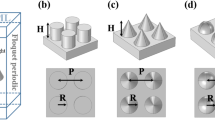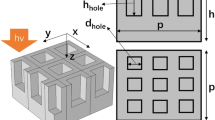Abstract
We investigated the influence of geometric parameters on the light absorption of gallium nitride (GaN) nanoarrays with hexagonal periodic arrangement by the finite element analysis method. In this article, we simulated the various structural parameters of GaN nanostructure to obtain the optimum optical efficiency over the substrate filling rates (FRs) ranging from 0.2 to 0.9. It was found that non-uniform hexagonal pyramid nanostructure achieved more significant and broadband light absorption than that of uniform structures in ultraviolet wavelength range from 200 to 400 nm. Simulation results indicate that the non-uniform hexagonal pyramid nanostructure can reduce the reflection on the substrate surface and increase the optical absorption. The distribution non-uniformity can be used as an attempt to improve the light absorption efficiency for optoelectronic device performance. We also analyzed the effects of cross- sectional shape, angles of incident light, and wire-to-wire spacing on the optical absorption of various GaN structures. In conclusion, non-uniform hexagonal pyramid nanostructure (FR = 0.8) with hexagonal periodic arrangement shows significant enhancement of optical absorption. All the results provide an effective solution to enhance optical properties for GaN ultraviolet photocathode.








Similar content being viewed by others
References
Antoine-Vincent N, Natali F, Mihailovic M, Vasson A, Leymarie J, Disseix P, Byrne D, Semond F, Massies J (2003) Determination of the refractive indices of AlN, GaN, and AlxGa1-xN grown on (111)Si substrates. J Appl Phys 93(9):5222–5226
Debnath R, Hangarter CM, Josell D (2016) 3D geometries: enabling optimization toward the inherent limits of thin-film photovoltaics. Springer Series in Materials Science 218:1–24
França CA, Guerra Y, Valadão DRB, Holanda J, Padrón-Hernández E (2017) Transmission electron microscopy as a realistic data source for the micromagnetic simulation of polycrystalline nickel nanowires. Comput Mater Sci 128:42–44
Fujii T, Gao Y, Sharma R, Hu EL, DenBaars SP, Nakamura S (2004) Increase in the extraction efficiency of GaN-based light-emitting diodes via surface roughening. Appl Phys Lett 84(6):855–857
Golam Sarwar ATM, Leung B, Wang GT, Myers RC (2018) Hexagonal nanopyramidal prisms of nearly intrinsic InN on patterned GaN nanowire arrays. Cryst Growth Des 18(2):1191–1197
Han L, Zhao H (2014) Surface antireflection properties of GaN nanostructures with various effective refractive index profiles. Opt Express 22(26):31907.9
Haomin G, Long W, Xinhua L, Zhifei Z, Yuqi W (2011) Analysis of optical absorption in GaAs nanowire arrays. Nanoscale Res Lett 6:617
Ho TW, Hong FCN (2012) A reliable method to grow vertically-aligned silicon nanowires by a novel ramp-cooling process. Appl Surf Sci 258(20):7989–7996
Holanda J, Campos CLAV, Franca CA, Padrón-Hernández E (2014) Effective surface anisotropy in polycrystalline ferromagnetic nanowires. J Alloys Compd 617:639–641
Kuo YK, Wang TH, Chang JY et al (2012) Advantages of blue InGaN light-emitting diodes with InGaN-AlGaN-InGaN barriers. Appl Phys Lett 100(3):031112–031113
Li J, Yu H, Wong SM, Li X, Zhang G, Lo PG, Kwong DL (2009) Design guidelines of periodic Si nanowire arrays for solar cell application. Appl Phys Lett 95(243113):1–3
Li X et al (2011) Bridging electromagnetic and carrier transport calculations for three-dimensional modelling of plasmonic solar cells. 19:0–0
Lin H, Xiu F, Fang M, Yip SP, Cheung HY, Wang FY, Han N, Chan KS, Wong CY, Ho JC (2014) Rational design of inverted nanopencil arrays forcost-ef-fective, broadband, and omnidirectional light harvesting. ACS Nano 8:3752–3760
Liu L, Diao Y, Xia SH, Lu FF, Tian J (2019) A first principle study on systematic stability and electronic properties of GaN nanowire surface with Cs/Li/NF3 co-adsorption. Appl Surf Sci 478:393–397
Liu L, Lu FF, Tian J (2020) Exploring the high stability of NEA GaN nanowire photocathodes by activation methods: first principles. Appl Surf Sci 508:145250
Peng XC, Wang Z, Liu Y, Manos DM, Poelker M, Stutzman M, Tang B, Zhang SK, Zou JJ (2019) Optical-resonance-enhanced photoemission from nanostructured GaAs photocathodes. Physical Review Applied 12:064002
Tang G, Yan F, Chen X, Luo W (2018) High-quantum-efficiency ultraviolet solar-blind AlGaN photocathode detector with a sharp spectral sensitivity threshold at 300 nm. Appl Opt 57(27):8060–8064
Wang K, Rongguo F, Wang G, Tran HC, Chang BK, Yang L (2017) High-performance photon-enhanced thermionic emission solar energy converters with AlxGa1-xAs/GaAs cathode under multilevel built-in electric field. Opt Commun 402:85–90
Wen L, Zhao Z, Li X, Shen Y, Guo H, Wang Y (2011) Theoretical analysis and modeling of light trappig in high efficiency GaAs nanowire array solar cells. Appl Phys Lett 99(143116):1–3
Xia SH, Liu L, Diao Y, Feng S (2017) Research on quantum efficiency and photoemission characteristics of exponential-doping GaN nanowire photocathode. J Mater Sci 52:12795–12805
Xu Z, Huangfu H, He L, Wang J, Yang D, Guo J, Wang H (2017) Light-trapping properties of the si inclined nanowire arrays. Opt Commun 382:332–336
Yang M, Guo J, Xiaoqian F, Liu Z (2018) Quantum efficiency of heterostructured AlN/AlxGa1−xN photocathodes with graded bandgap emission layer. J Mater Sci Mater Electron 29(14):12443–12450
Zou JJ, Ge XW, Zhang YJ, Deng WJ, Zhu ZF, Wang WL, Peng XC, Chen ZP, Chang BK (2016) Negative electron affinity GaAs wire-array photocathodes. Opt Express 24:4632–4639
Acknowledgments
Qinghua Lv of Hubei University of Technology is greatly appreciated for the help of COMSOL Multiphysics Business Package calculations.
Funding
This work is supported by Qing Lan Project of Jiangsu Province, China (Grant No. 2017-AD41779) and the Six Talent Peaks Project in Jiangsu Province, China (Grant No. 2015-XCL-008).
Author information
Authors and Affiliations
Corresponding author
Ethics declarations
Conflict of interest
The authors declare that they have no conflict of interest.
Additional information
Publisher’s note
Springer Nature remains neutral with regard to jurisdictional claims in published maps and institutional affiliations.
Rights and permissions
About this article
Cite this article
Lv, Z., Liu, L., Zhangyang, X. et al. Optical absorption enhancement in GaN nanowire arrays with hexagonal periodic arrangement for UV photocathode. J Nanopart Res 23, 24 (2021). https://doi.org/10.1007/s11051-020-05128-7
Received:
Accepted:
Published:
DOI: https://doi.org/10.1007/s11051-020-05128-7




